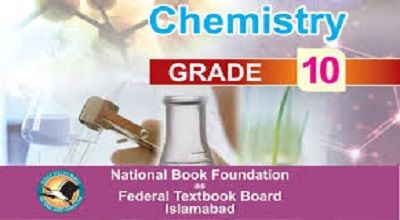Chemistry class 10 FBISE
Chemistry class 10 FBISE: Chemistry is a branch of science that deals with the study of matter, its properties, composition, and the changes it undergoes. It plays a crucial role in understanding the natural world and the technological advancements that shape our daily lives. In this textbook, we will explore the fundamental concepts of chemistry that are essential for students in Class 10.
Chapter 1: Chemical Reactions and Equations
1.1 Understanding Chemical Reactions
Chemical reactions involve the transformation of substances into new substances with different properties. During a reaction, the bonds between atoms in the reactants are broken and new bonds are formed to create the products.
1.2 Writing Chemical Equations
Chemical equations represent chemical reactions using symbols and formulas. A balanced chemical equation has the same number of atoms of each element on both sides, ensuring the law of conservation of mass is upheld.
1.3 Types of Chemical Reactions
- Combination Reactions: Two or more substances combine to form a single product.
- Decomposition Reactions: A single compound breaks down into two or more simpler substances.
- Displacement Reactions: An element displaces another element in a compound.
- Double Displacement Reactions: Ions in two compounds exchange places to form two new compounds.
Chapter 2: Acids, Bases, and Salts
2.1 Understanding Acids and Bases
Acids are substances that release hydrogen ions (H⁺) in solution, while bases release hydroxide ions (OH⁻). The pH scale measures the acidity or basicity of a solution, ranging from 0 to 14.
2.2 Properties of Acids and Bases
Acids taste sour, turn blue litmus paper red, and react with metals to produce hydrogen gas. Bases taste bitter, feel slippery, and turn red litmus paper blue.
2.3 Salts
Salts are formed from the neutralization reaction between an acid and a base. They consist of positive ions (cations) from the base and negative ions (anions) from the acid.
2.4 The pH Scale
The pH scale is a measure of hydrogen ion concentration. A pH of 7 is neutral, values less than 7 indicate acidity and values greater than 7 indicate basicity.
Chapter 3: Metals and Non-Metals
3.1 Properties of Metals
Metals are typically shiny, malleable, ductile, and good conductors of heat and electricity. They tend to lose electrons to form positive ions.
3.2 Properties of Non-Metals
Non-metals are generally dull, brittle, and poor conductors of heat and electricity. They tend to gain electrons to form negative ions.
3.3 Reactivity Series
The reactivity series is a list of metals arranged in order of decreasing reactivity. It helps predict how metals will react with acids, water, and other substances.
3.4 Corrosion and its Prevention
Corrosion is the gradual destruction of metals by chemical reactions with the environment. Prevention methods include painting, galvanization, and using corrosion-resistant materials.
Chapter 4: Carbon and its Compounds
4.1 Introduction to Carbon
Carbon is a versatile element that forms the basis of organic chemistry. It can form four covalent bonds and exists in various forms, including diamond, graphite, and fullerenes.
4.2 Hydrocarbons
Hydrocarbons are compounds made up of only carbon and hydrogen. They can be classified into alkanes, alkenes, and alkynes based on the types of bonds between carbon atoms.
4.3 Functional Groups
Functional groups are specific groups of atoms within molecules that determine the chemical properties of those molecules. Examples include hydroxyl (-OH), carboxyl (-COOH), and amino (-NH₂) groups.
4.4 Homologous Series
A homologous series is a group of organic compounds with a similar structure and chemical properties, where each successive member differs by a CH₂ unit.
Chapter 5: Periodic Classification of Elements
5.1 Mendeleev’s Periodic Table
Dmitri Mendeleev created the first periodic table, arranging elements by increasing atomic mass and grouping them based on similar properties.
5.2 Modern Periodic Table
The modern periodic table arranges elements by increasing atomic number. Elements are organized into periods (rows) and groups (columns) based on their electron configurations.
5.3 Trends in the Periodic Table
- Atomic Radius: Decreases across a period and increases down a group.
- Ionization Energy: Increases across a period and decreases down a group.
- Electronegativity: Increases across a period and decreases down a group.
Chapter 6: Life Processes
6.1 Photosynthesis
Photosynthesis is the process by which green plants convert carbon dioxide and water into glucose and oxygen using sunlight. It takes place in the chloroplasts of plant cells.
6.2 Respiration
Respiration is the process of breaking down glucose to release energy for cellular activities. It can be aerobic (with oxygen) or anaerobic (without oxygen).
6.3 Nutrition
Nutrition involves the intake and utilization of food by organisms. It can be autotrophic (self-feeding, as in plants) or heterotrophic (feeding on other organisms).
6.4 Transportation
Transportation in living organisms involves the movement of substances like water, nutrients, and gases. In animals, it is carried out by the circulatory system, while in plants, it is managed by xylem and phloem tissues.
Chapter 7: Control and Coordination
7.1 Nervous System
The nervous system controls and coordinates body activities through a network of neurons. It consists of the central nervous system (brain and spinal cord) and the peripheral nervous system.
7.2 Hormonal Control
Hormones are chemical messengers produced by endocrine glands. They regulate various functions like growth, metabolism, and reproduction.
7.3 Reflex Actions
Reflex actions are quick, involuntary responses to stimuli. They are controlled by the spinal cord and protect the body from harm.
Download The Textbook in PDF Format =====> Free Link
Conclusion
This textbook provides a foundational understanding of chemistry concepts essential for Class 10 students. By studying these chapters, students will gain insights into the composition, properties, and transformations of matter, preparing them for advanced studies in science.
